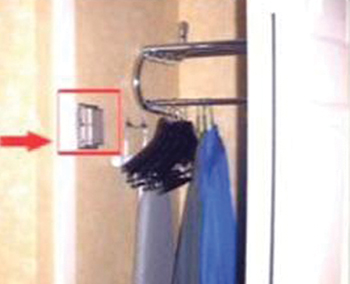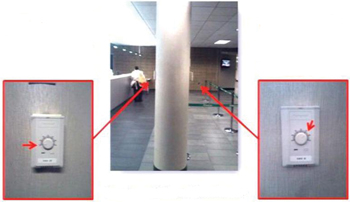By Barry A. Cipra
John Burns has a reading list for mathematicians. On it are papers from the journals Energy and Buildings and Building and Environment. He also recommends the Journal of Building Performance Simulation (whose parent organization, IBPSA (the International Building Performance Simulation Association), runs a biennial meeting).
In July, in a joint invited address at the 2013 SIAM Annual Meeting and Conference on Control and its Applications, Burns, a control theorist at Virginia Tech, urged the audience to take advantage of the virtually unlimited opportunities to apply mathematical principles to the problem of designing truly energy-efficient buildings. For inspiration, he showed a series of slides listing dozens of mathematics-intensive papers published in journals most mathematicians have never heard of—those mentioned above are just a few of the possibilities—all in the first half of 2013.
Take, for example, a paper from Building and Environment: “Study for Flow and Mass Transfer in Toilet Bowl by Using Toilet Seat Adopting Odor/Bacteria Suction Feature,” by Korean engineers Youngjin Seo and Il Seouk Park. “Guess what,” Burns says. “Most of that is CFD analysis. Computational fluid dynamics.”
The titles, Burns says, make clear that buildings are understood to be complex, multiscale, nonlinear, infinite-dimensional systems with hundreds of components that call for modeling, control, optimization, and other cornerstones of applied mathematics. In short, he says, “It’s a SIAM kind of problem.”
To be sure, it’s a problem that anyone who’s ever had a drafty window—or anyone who’s ever shivered through a talk in a frigid hotel ballroom—can appreciate. Buildings consume enormous amounts of energy. They account for roughly 39% of total U.S. energy consumption, including 71% of electric power and 54% of natural gas. Each year, Americans pour more than 600 kilowatt-hours per square meter (roughly the rate of consumption of a 60-watt light bulb left on in a clothes closet) into heating, cooling, lighting, and otherwise utilizing their homes, office buildings, shopping centers, warehouses, and manufacturing plants. The Department of Defense alone spends billions of dollars on the energy needs of its more than 300,000 buildings’ 2.2 billion square feet. (In comparison, Walmart owns approximately 4400 stores spanning roughly 690 million square feet.) DoD is also concerned that many of its buildings receive their power from the nation’s commercial grid, with all the vulnerabilities that that implies.
In 2009, then-secretary of energy Steven Chu cited the need to develop design tools that would reduce the energy consumption of residential and commercial buildings by upward of 80%, with a 10-year return-on-investment target. A 70% reduction, Burns points out, would be equivalent to bringing the entire U.S. transportation system to a halt.
One solution, of course, is obvious, Burns notes. “If you want an energy-efficient building, it’s real simple: You turn out the lights, lock the doors, turn off the heat.” The challenge, of course, is to create something people can live and work in.
One challenge for mathematicians will be overcoming barriers in the current technological “infrastructure”—models, templates, procedures—of the building design process. Another challenge will be dispelling some misconceptions on the part of building designers about mathematics and mathematical modeling.
The first mathematical challenge is to come up with useful models. The computer tools that designers currently use were not created with optimization and control in mind. Most existing computational tools focus on energy simulations, and although these tools are very good for that purpose, it is nearly impossible to use them for control or optimization. Therein lies one of the misconceptions, Burns says: Many people think that if you can simulate a system, then you can control and optimize it. But mathematicians know better. They need to create new models and new modeling tools that incorporate the powerful techniques of optimization and control; most important, the new tools will need to solve problems of actual significance. “It’s not enough to produce a model,” Burns says. “You don’t want to produce one that’s irrelevant.”
That isn’t a call for super-high-fidelity models. In fact, Burns says, another misconception is that control and optimization are impossible in the absence of high-fidelity simulations. “People in control know that’s not true,” he says. “We design controllers with some really bad, low-order models, and they work well in practice because the controllers are designed to be robust.”
The algorithms do need to be able to deal with everything from a single room in a small house to an entire complex of skyscrapers. “The methods have to be scalable, and you want them to interface with other control tools,” Burns notes. They will also need to cope with unpredictability. Buildings are monuments to uncertainty, both in the physical conditions they face (most notably the weather) and in the ways they are utilized, with people coming and going and using or ignoring the amenities provided: An auditorium that’s comfortable with a hundred people in it can be a furnace with a thousand, or an icebox with a dozen.
Often overlooked in this area is the power that mathematical analyses can bring to bear on integrating the various aspects of energy efficiency. One of the most telling misconceptions, Burns says, is summed up in the words of one building designer: “I don’t need a mathematical model or a supercomputer to tell me where to put a thermostat.”
In the San Diego talk, Burns followed this up with a couple of photographs (Figure 1): One, which he had taken in a hotel room, showed the thermostat conveniently located inside a closet. The other, supplied by a colleague, showed a pillar in the middle of an airport concourse with thermostats on opposing sides; a pair of close-ups for the latter revealed that the two thermostats were set at different temperatures.
 
Figure 1. Optimal thermostat placement? The thermostat in the hotel room shown at left had been placed in a closet. A pillar in an airport concourse (right, courtesy of Bryan Eisenhower) had thermostats on opposing sides, set at different temperatures.
|
Burns continued with a small case study he and colleagues had done for the optimal placement of a thermostat in a two-bed hospital room. A simple floor plan showed the locations of doors and airvents in the room and adjacent bathroom. After glancing at the plan, a building designer concluded that the thermostat should be positioned beside the door between the room and bathroom. Burns’s group let math decide on the placement. They set up and solved a system of convection–diffusion equations based on airflow patterns in the room. Then, taking a brute-force approach, they “marched” the thermostat around the room, looking for the position that gave the most accurate indication of the actual ambient temperature in the room. The designer’s choice of a position beside the door, they found, wasn’t bad, but a far better choice turned out to be on the wall directly opposite that door. Just a modicum of optimization can, in principle, improve comfort while simultaneously cutting the costs of heating and cooling. Even better would be to model the whole enchilada, optimizing placement not just of the thermostat, but also of the airvents.
What the designer accomplished in a glance, however, chewed up 22 hours of a desktop computer’s time. But that was because the mathematicians intentionally used a slow, brute-force algorithm. To make their methods practical, so that they can apply not just to a single room but to entire buildings, mathematical modelers will need to take “smart” approaches, Burns notes. Even in an age of petaflop machines, algorithms still rule. Burns’s group adopted just such an approach: Using a PDE trust-region algorithm and a multigrid-like optimization model, they were able to reduce the computation by an order of magnitude on the same workstation.
How much of a dent can math make in the world of energy-efficient building design? “There are possibilities for short-term successes,” Burns says. “You’re not going to be able to do all buildings this way. But big-box stores and cookie-cutter stores are where I think we could make big impact.” If one run of an algorithm can cut the costs of operating a hundred identical buildings, the computer cycles will be well worth it.
Barry A. Cipra is a mathematician and writer based in Northfield, Minnesota.